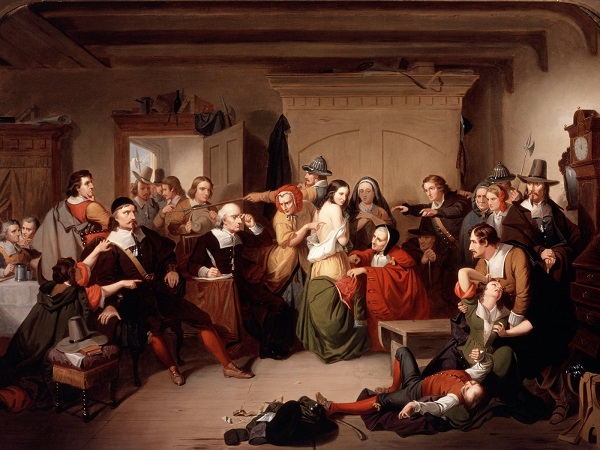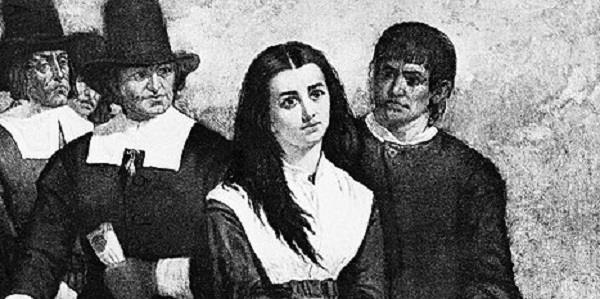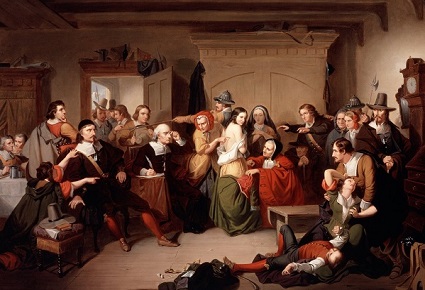It is well known that in 1692 a hysteria of witch-hunting spread throughout the region of Salem, Massachusetts, leading the Puritan government there to put to death twenty persons and imprison about one hundred and fifty more. What is less known is that this outbreak of hysteria was initiated by the anti-Catholic bigotry of the Puritan settlers and the scandalous unjust trial and execution of a Catholic washer woman a few years prior to the famous Salem Witch Trials of 1692. In this essay we shall explore the anti-Catholic bigotry that underlay the Salem Witch Trials.

The Hard Life of Goody Glover
In 1688, Ann Glover, known as “Goody Glover”, an Irish-Catholic immigrant, was put to death in Salem on charges of witchcraft. Her condemnation had more to do with her Catholicism than any sorcery. It was the trial and death of Goody Glover that fueled the fires of the hysteria that broke out in Salem only four years later.
Life had dealt Ann “Goody” Glover a cruel hand. As a young woman in Ireland she was captured by Oliver Cromwell’s army during their ravages of that country. She and her husband were sold as slaves and sent to Barbados. The little-known practice of selling Irish as slaves was inaugurated by James I in 1612; most slaves were sent to the West Indies or South America; the Amazon Basin, too, was a popular destination. In 1625 a law was passed mandating the sale of Irish political prisoners to English planters, mostly in the West Indies. It was under this law that Cromwell sold Ann Glover and her husband to planters in Barbados. While in Barbados, Ann Glover’s husband was allegedly executed because he would not renounce the Catholic Faith.
Glover and her children eventually left Barbados; whether they were emancipated or escaped, we do not know. They migrated to North America and settled in the Boston area, where she and her daughter became the servants in the household of a Mr. John Goodwin. In 1688, one of the Goodwin girls, 13-year old Martha, accused the daughter of Ann Glover of stealing fabric and ran her out of the house in tears. This prompted Ann Glover to come over and have words with Martha. Allegedly the encounter was fierce and Ann Glover shouted at Martha so vehemently that Martha took ill.
In the days following the incident the children of the Goodwins began to fall ill. John Goodwin brought in a physician to attend to the children, but when he could neither heal them nor even diagnose their illness, he told the father that evil spirits were at work. Suspicion immediately fell on Ann Glover, a foreigner who could not speak English and was generally disliked by the Puritans.
The famous minister Cotton Mather was summoned to pray for the Goodwin children, but much to his irritation the illness continued. A few days later, five ministers came from the surrounding towns to pray for the Goodwin children, and after this prayer session there seemed to be some marked improvement in a few of them.
In the meantime, the Salem magistrates had found out about the experiences of the children, and upon questioning Mr. Goodwin were told that he believed Ann Glover to be responsible. Ann Glover was summoned before the magistrates and ordered to repeat the Lord’s Prayer. Being that she was not a native English speaker, she stated that she could only recite it in Gaelic or Latin. This alarmed the judges, who began to question whether the woman were a Christian at all. Her answer to the question “Do you believe in God” was unintelligible and the magistrates became convinced of her guilt. She was sent away to jail to await trial while more evidence was sought against her. After her imprisonment, the condition of the Goodwin children continued to improve, leading some to conclude that Glover was in fact connected with their illness.
Catholicism on Trial
During the investigation it was discovered that Ann Glover was in fact a Roman Catholic, who Cotton Mather referred to as “a scandalous old Irishwoman, very poor, a Roman Catholic and obstinate in idolatry”, and in another place she is called “and ignorant and a scandalous old Woman” (1). She was asked again to recite the Our Father, for it was commonly believed that the Our Father could not be recited by a witch. She could not do it in English, of course, but she did do it in Latin. This irked Mather, but it did not help Glover, as Mather noted that though she could say most of the prayer, she could not complete it. Recall that Protestants end the Our Father with the phrase “For the kingdom, the power and the glory is yours, now and forever”, while Catholics do not. Thus, when Ann Glover could not say the ending of the prayer, it was due to the simple fact that she was reciting the Catholic form, which ironically is the form as taught by Christ, since the doxology appended by Protestants is not found in the Bible.
Glover’s inability to complete the Lord’s Prayer confirmed her guilt. A search of her house turned up what Mather referred to as several “small images” that were apparently stuffed (2). She was interrogated about what the purpose of these dolls was an allegedly claimed that they were for purposes of witchcraft.
At this point we must pause and recall that Glover could not speak English. Mather and her accusers could not speak with her directly. Two Puritan men who claimed to know Gaelic, “honest and faithful men”, as Cotton Mather said, were used as interpreters (3). Subsequent events have led later generations of historians to wonder to what degree these fellows really knew Gaelic at all or if there was not some intentional misrepresentation of Mrs. Glover’s defense.
“Spectral Evidence”
At any rate, Ann Glover “confessed” to using the dolls for purpose of witchcraft. Once it was known she had been accused, others came forward making accusations against her based on hearsay and “spectral evidence” (evidence of witchcraft based on dreams and visions and legally admissible in English courts at the time). Goody Glover’s responses to her accusers were bizarre and contradictory, leading some to think she may have in fact been mentally ill and not at all guilty of witchcraft. Mather himself admits this as a possibility and says that six physicians were ordered to examine her: “The Court appointed five or six Physicians one evening to examine her very strictly, whether she were not craz’d in her Intellectuals, and had not procured to her self by Folly and Madness the Reputation of a Witch.” [4]
The doctors found her competent and Ann Glover was pronounced guilty and sentenced to death. Mather went to visit her in prison, during which time Glover allegedly confessed that she had engaged in nighttime trysts with the devil and other evil spirits. This confession is certainly questionable, as Mather goes on to say “She entertained me with nothing but Irish, which Language I had not Learning enough to understand” (5).
Praying to Spirits
Throughout Glover’s ordeal, anti-Catholic prejudice and language barriers worked against her. For example, when Mather was interrogating her on the question of whether or not she worshiped the devil, Ann allegedly told Mather that she prayed to a host of spirits, which Mather took to be demons. However, knowing that Glover spoke Gaelic, that Mather could not understand Gaelic, that the integrity of her translators was questionable, and that the Puritans were predisposed to condemn her because of their hatred of Catholicism, let us look at her statement about praying to “spirits” in light of a stunning statement Mather makes next.
After describing the conversation in which Ann Glover admits to praying to “Catholic spirits” (demons to Mather), Cotton Mather himself says, “They were her Spirits, or her Saints, (for they say, the same Word in Irish signifies both)”(6). It is not known where in Ireland Ann Glover was from or what dialect or slang she was using, but here Mather plainly admits that what the Puritans took to be demon worship could have been nothing other than the Catholic invocation of the saints. If Glover was invoking the saints, could not the “images” the Puritans found be crude representations of the saints, images of the “spirits” that Mather accused her of worshiping? It may be so, given the Puritan hatred of the Catholic Communion of Saints and Mather’s accusation of Glover as “idolatrous.”
The Enigmatic Last Words of Goody Glover
When Glover was taken out to be hanged, she stated that her death would not relieve the children of their malady. Her final words were enigmatic; according to some, she said that the children would continue to suffer because there were other witches besides her who had been involved in their affliction. When asked to name these others, she steadfastly refused. Another account says that Glover said that killing her would be useless because it must have been someone else, not her, who was responsible. When asked who, she said she did not know. Clearly one version of her last words incriminates her, while the other is quite in keeping with the disposition of one who knows they are being put to death unjustly. We may again presume the language barrier to be responsible for the ambiguity of her last words.

In either case, her words were taken to mean that there must be other witches operating in the Salem area. The enigmatic words from the lips of a condemned papist-witch fueled the anxiety and suspicion that would burst upon Salem four years later.
The mob of Salem surrounded Ann Glover and jeered her as she was put to death. A witness described the scene: “There was a great concourse of people to see if the Papist would relent, her one cat was there, fearsome to see…Before her executioners she was bold and impudent, making to forgive her accusers and those who put her off” (7).
“They did her cruel…she died a Catholic”
The general consensus today is that Goody Glover was a faithful Catholic who may have been suffering from an onset of dementia. Even in her own day, not everyone was convinced of her guilt. Sir Robert Calef, a Boston author and historian who condemned the witchcraft hysteria, recalled: “In the times of sir Edmond Andros’s government, Goody Glover, a despised, crazy, ill-conditioned old woman, an Irish Roman Catholic, was tried for afflicting Goodwin’s children; by the account of which trial, taken in short hand for the use of the jury, it may appear that the generality of her answers were nonsense, and her behaviour like that of one distracted. They did her cruel. The proof against her was wholly deficient. The jury brought her guilty. She was hung. She died a Catholic” (8).
Anti-Catholic bias was evident throughout her trial. Her “inability” to “finish” the Our Father; the “Catholic spirits” (or saints?) Glover prayed to which Mather said were demons; at one point, Mather held up as evidence the fact that Ann Glover would consent “to read popish books” but refused “to read books against popery” (9). Recall also the “images” found in her house. During her trial she was shown one of these “images” and asked if she were a papist. She grabbed the “image”, clutched it to her heart and said, “I die a Catholic!” (10) From beginning to end anti-Catholicism was evident in Glover’s condemnation, for in New England at the time, “witch”, “devil” and “Catholic” were three words that described the same reality. A sermon preached some years prior to Glover’s death affirms this supposition: “Because of witchcraft we have divers mischiefs and disorders; and witches they be so long as there be papists, drabs of the strumpet pope” (11). Ralph Hoven, an Anglican theologian of the period, also stated that “All papists be not witches, but commonly all witches be the spawn of the pope” (12).
Goody Glover may have been unpopular, she may have suffered from mild dementia, she might have been ill-tempered, but she was certainly not a witch. She had the misfortune to be Catholic in a place and time where Catholicism and devil worship were synonymous. Her tragic death by hanging in 1688 was the first killing in what would evolve into the Salem Witch Trials, as scores of individuals were accused, tried and either imprisoned or hanged based on the fear that was fed by the unjust condemnation of Ann Glover.
(1) Cotton Mather, Magnalia Christi Americana, 1702; Cotton Mather, Memorable Providences , Relating to Witchcraft and Possessions (1689), Sec. III
(2) Cotton Mather, Memorable Providences, Sec. VIII.
(3) ibid.
(4) ibid.
(5) ibid., Sec. X
(6) ibid.
(7) Journal of the American-Irish Historical Society, Volume 5 (1905), pg. 21
(8) Robert Calef, More Wonders of the Invisible World or The Wonders of the Invisible World Displayed (Printed in London, 1700, reprinted in Salem by John D. & T.C. Cushing, Jr. for Cushing and Appleton: 1823), p 299
(9) Journal of the American-Irish Historical Society, Volume 5 (1905), pg. 20
(10) ibid.
(11) ibid., 16
(12) ibid.
For a balanced general overview of the Salem Witch Trials, see Leo Bonfanti, “The Witchcraft Hysteria of 1692”, New England Historical Series, Volume I (Wakefield, Mass: Pride Publications, 1971)
Phillip Campbell, “Anti-Catholicism in the Salem Witch Trials,” Unam Sanctam Catholicam, January 19, 2013. Available online at: www.unamsanctamcatholicam.com/anti-catholicism-in-the-salem-witch-trials

